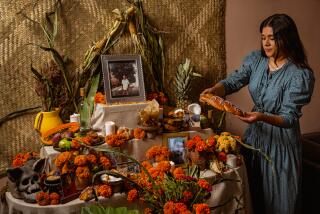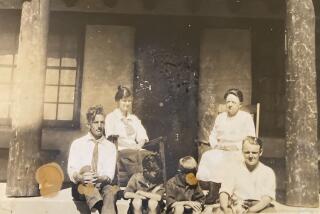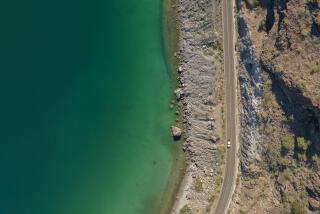Destination: Spain : Clinging to the Past : In the whitewashed, mountain villages of Las Alpujarras, goats wander the hills-- and sometimes outnumber tourists : The mist swirled around the buildings like a potent witches’ brew, fixing us in a spell.
- Share via
CAPILEIRA, Spain — Desperate for sunshine after three gloomy, drizzly January days amid the Moorish towers and fortress walls of Granada, my girlfriend, Lisa, and I decided to head for Spain’s Mediterranean coast, about 40 miles south.
As our car climbed through the snow-capped Sierra Nevada, the clouds suddenly parted to reveal a sharp blue sky and a string of several whitewashed villages in a remarkable alpine region called Las Alpujarras. What we’d planned as a quick, scenic detour turned into a three-day stopover--and left us with the most exhilarating and indelible memories of our trip.
Las Alpujarras is just 45 minutes from Granada by car. But shortly after the Alpujarras turnoff from the major southbound highway that leads to the coast, the road becomes narrow and, at times, hair-raising, winding steadily through a typical Mediterranean landscape of olive and fruit trees and terraced fields carved out of steep hillsides.
Thanks in part to that challenging drive, Las Alpujarras has remained relatively undiscovered by Spanish tourist standards.
It was one of the country’s most isolated regions when British author Gerald Brenan moved to the tiny village of Yegen in the 1920s and later described his experiences in the popular book “South from Granada.” Today, the region is a popular summer retreat for residents of Granada, who come to hike and shop for locally made pottery, carpets and colorful, striped blankets. (Though it was sunny and mild during our brief stay, in winter snowfall in the higher reaches may make travel difficult, and daytime temperatures typically fall between 40 and 65 degrees).
But its reputation barely extends beyond the Spanish border; even in midsummer, the words Las Alpujarras just don’t have the same ring as Costa del Sol to your average German or Brit (the most common foreign visitors to the area).
The region encompasses about two dozen rustic settlements spread in a rough circle about 30 miles wide, as if the gods had draped a necklace over the mountains and each jewel was a village. Populations vary from about 100 to 5,000, and the primary occupation is farming.
Following Ferdinand and Isabella’s defeat of the Moors in 1492, virtually every culture and people chased out of Granada in that infamous history of purges took refuge here--from Moors to Berbers to Jews to Gypsies.
The area’s exotic past lives on: Moorish aqueducts still supply water to both villagers and citrus groves. And though the building style and street plans are hardly as elaborate as Granada’s barrios and palaces, they nonetheless bear the distinct signature of Moorish architects.
*
Our first day, after we’d turned off the highway to the coast, we drove by groves of palm, olive and citrus trees; ripe black olives, oranges and lemons glowed in the sunshine like drops of pure color on a dark-green etching. We crossed ancient one-lane bridges. We passed a man on a Vespa with a bundle of wood in a wicker basket strapped to his back, a rabbit hunter with his dog and a shepherd with his sheep.
Our first stop was Lanjaron. One of the largest towns in Las Alpujarras, Lanjaron is built on a bluff overlooking a wide valley laced with olive trees and, to the south, a wall of sharp peaks dusted with snow. It’s well known for its medicinal spa and spring water, which is bottled and sold throughout the country.
As we got out of the car to stretch our legs, I noticed what seemed to be a shop with strands of beads hanging in the door frame. We pushed through the beads and were immediately overwhelmed by a sweet, rich scent in what turned out to be a butcher shop. The source: hanging, briefcase-size cured hams from Trevelez, which at roughly 5,000 feet is the highest of the Alpujarras villages. I later read that Trevelez ham, called jamon serrano, is famous throughout Spain. After lunching on garlicky soup, thick bread and thin slices of that succulent ham in the cafe next to the butcher shop, I’m only surprised that jamon serrano isn’t famous worldwide.
We hopped back into the car and continued to climb. The landscape grew even more dramatic, with sheer cacti-lined precipices and boulders the size of the car, and the towns became more quaint. While Lanjaron’s main drag has the simple elegance of most small towns in this part of the world, the higher Alpujarras villages are clusters of rustic one- and two- story buildings with thatched roofs over their terraces. Roads become cobbled footpaths. Cathedrals become little white chapels.
About 1,000 feet below the snow line, cut into the shoulder of the deep Poqueira Gorge, we discovered Capileira, a town we didn’t want to leave.
Capileira bears several striking similarities to Santorini, Greece: whitewashed houses, narrow donkey paths zigzagging up an almost sheer grade, cobblestone alleys and marshmallow-shaped chimneys. But while Santorini is a tourist mecca, in Capileira (pop. 500) we were one of a handful of visitors. Instead, the streets are full of playing children, gossiping widows and the occasional young Spanish couple from Granada. We also noticed trickling waterways, public fountains bubbling with pure spring water and the clanking of goat bells. (Goats wander the village at will.) The overall feel is homey and safe and rejuvenating.
*
We drove to the top of the village and stumbled onto the Finca Los Llanos, a building of “tourist apartments” that instantly appealed to us. It’s one of a handful of lodgings in town and is not difficult to find, since you can walk from one end of Capileira to the other in about eight minutes. Finca Los Llanos is a free-standing structure two or three blocks above the main square and looking out over the town. For $45 a night we rented a sprawling, clean apartment with an open fireplace, fully equipped kitchen, combined living and dining room, bedroom, bathroom, simple but comfortable pine furniture, television and plentiful running hot water. It also included the services of hardy village boys who wore pressed white shirts and would happily bring us firewood or whatever else we needed.
We stepped onto our eagle’s nest of a balcony and gazed down at the picturesque village hugging the hill beneath us. The terraced and wooded Poqueira Gorge is deep enough for instant vertigo, and because the gorge drops thousands of feet, the jagged peaks and alpine meadows on the opposite side seem to hang right over Capileira. We took in the view with gulps of the fresh mountain air.
We’d bought some dinner supplies at a market in Lanjaron, but after arriving at our hotel in Capileira we realized we’d forgotten bread. It was about 8 p.m., and we decided to take a pre-dinner stroll to Bubion, a neighboring town about half an hour away by foot, to see if we could buy some. The moon was bright and full. It lighted up the road and the craggy, stone-pitted slopes like twilight. As we walked, we could hear little springs gurgling all around us. Pigs grunted somewhere in the olive and oak groves.
In town, we stopped at a cafe whose owner sold us some fresh bread and two cups of the best espresso we’d tasted in Spain. There were only three other customers that evening, middle-aged men whose leathered faces reflected lives spent at outdoor manual labor. (Though we felt welcome throughout the region, most cafes in the higher reaches of Las Alpujarras are de facto men’s clubs; we never encountered a woman sitting alone, and most couples we saw were visitors.)
When we got back to our apartment, we built a big, hissing fire. We wrote and read by candlelight as the fire burned down to coals. Then we piled food into pouches of aluminum foil--boneless breast of chicken, olive oil, garlic, salt and rosemary in one; onions, quartered potatoes and olive oil in the other--and threw them on the embers. Twenty minutes later, we squeezed lemon on the perfectly cooked chicken and ate it with sharp local goat’s cheese, the roasted potatoes and a good bottle of Rioja. The bill for this extraordinary feast: about $6 each.
We woke the next morning to another deep blue sky. Above us, the sunrise turned the snow pink across the jagged peaks. Immediately below us, thick morning mist pooled in the valley. It flowed and swirled around the buildings of lower Capileira like a potent witches’ brew, fixing us in a spell of euphoria. It was strange to think that the sunlight and magic we thought we’d encounter along the Mediterranean coast were to be found here, in the middle of winter, in this tiny mountain village.
(BEGIN TEXT OF INFOBOX / INFOGRAPHIC)
GUIDEBOOK
Roaming in Las Alpujarras
Getting there: A direct public bus runs twice a day from Granada to Las Alpujarras. The trip costs about $6 per person and takes roughly two hours.
But if you can stomach the hair-raising roads, renting a car is strongly advisable. It gives you the freedom to explore the various towns at whim, as well as make day excursions back to Granada or down to the Mediterranean coast.
To reach Las Alpujarras from Granada, take highway N323 south (follow the signs to Motril) for about 25 miles. Then turn left at the C333 exit (you can’t turn right). This is the road that climbs the high Sierra Nevada and links the Alpujarras villages.
Where to stay: Lanjaron has the area’s largest selection of accommodations, with about 18 lodgings that range from pensions to small, three-star hotels costing about $55 per night, double. One of the more popular budget choices is the Hotel Espana (telephone 011-34-58-770187), about $34 per night, double.
Bubion offers the clean and comfortable Pension Las Terrazas (about $28 per night, double; tel. 011-34-58-733217) or the popular, three-star Villa Turistica del Poqueira (about $85 per night, double; tel. 011-34-58-763111). Possibilities in Capileira include the Finca Los Llanos, with its comfortable apartments (about $61 per night for two; tel. 011-34-58-763071) and the simpler Meson Poqueira (about $25 per night, double; tel. 011-34-58-763048).
For more information: The central tourist office in Granada (Mariana Pineda Square No. 8, Granada 180009; tel. 011-34-58-225990) has lists of hotel prices and phone numbers for the Alpujarras region. Staffers are very helpful, and they speak English. (In Las Alpujarras, by contrast, most hoteliers and shopkeepers speak only Spanish.) This office can also provide information on Alpujarras restaurants, festivals, arts and crafts and horseback riding, as well as the region’s celebrated hiking trails.
More to Read
Sign up for The Wild
We’ll help you find the best places to hike, bike and run, as well as the perfect silent spots for meditation and yoga.
You may occasionally receive promotional content from the Los Angeles Times.






